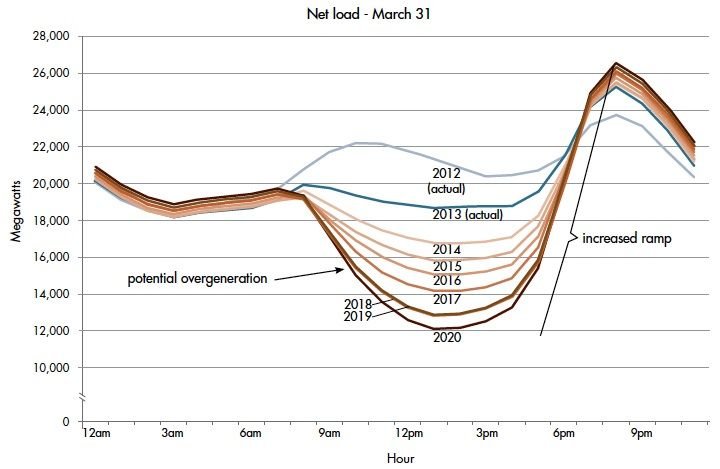Giant batteries for giant grids

The speed at which solar cells and wind turbines have not only become viable sources of energy, but often the cheapest forms of new capacity is an incredible feat. The challenge however is that while wind blows throughout a day and solar is extremely predictable, the produced load does not match when we typically use electricity. In two of the largest energy markets in the US – California and Texas – this is very noticeable. Historically, this has meant turning on extra capacity in the form of fossil fuel energy generators or buying that capacity from neighboring states. But large-scale battery installations are changing the math on where to pull energy when its needed.
Seeing the problem
The divergence between the expected load on a grid and the production of solar energy is best described with the “Duck Curve.” There are two load peaks in a day, one in the morning when a large number of people are getting ready for their day and another in the evening, they return home to cook dinner, turn on an HVAC system, watch television, and any number of activities that rely on electricity. These two peaks happen before and after much of the energy for solar can be produced, leaving many grids with both surpluses and shortages of energy. Working around this curve is both resource and capital expensive, which is why many governments and utility operators have tried to incentivize off-peak load shifting. Energy pricing during peak solar production can drop to nearly zero and even into the negatives if a business can reliably shed excess energy from the grid at a moment’s notice.

Figure 1 – This example of a duck curve is provided by the US Dept. of Energy
An opportunity for change
For power utilities, predictability is profitability. Knowing where energy will come from to power the grid and that it will be available at a moment’s notice are extremely valuable. And batteries are starting to fill this role alongside renewable generation capacity from solar and wind. By storing power in batteries during while electricity is cheap and plentiful, then putting it back on the grid when it is most needed, utilities can recoup the investment as they would with other modes of generation. But batteries also provide another benefit beyond removing backup fossil generation from the grid. The amount of power that can be released from batteries per unit time means fewer installations are needed during peak events. In a recent report from the NY Times, the batteries facilities in California delivered the effective output of 7 full-sized nuclear reactors in a few minutes. This is an incredible feat, especially considering only a handful of reactor designs can follow load needs and the rest require hours if not days to produce energy at capacity (that is why nuclear is often called base-load power).
Making the future
The incentives for making grid-scale battery storage are clear, but there are still hurdles to making it mainstream. Possibly the greatest hurdle is the cost. Many of the facilities installed today rely on the same lithium-ion technologies used in electric vehicles and personal electronics. That may provide some value, but it ignores one of the requirements that does not exist for stationary battery storage – it can be heavy. There is also the problem of scale. When so many more things are reliant on batteries, the available capacity for grid-storage is lessened. And there are also the environmental impacts of these large battery facilities, if the goal is to reduce carbon emissions the production of batteries needs to be as clean as possible.
Being able to solve these challenges quickly enough to capture the opportunities and do so sustainably for well into the future necessitates a comprehensive digital transformation. Starting in the early development of innovative battery technologies requires a wealth of information provided by simulation, manufacturer requirements, and an understanding of the possible value chain. Scaling production depends on easy access to transparent data and an experience pool, especially if creating capacity outside of the traditional centers of excellence. And making sure the batteries can enter a more circular market necessitates the reliable communication of data between many different stake holders, ensuring batteries can be re-use, refurbished, and recycled at their end-of-life. Siemens solutions and our expertise in process manufacturing for our customers in similar industries is helping battery companies accelerate their businesses for a more sustainable future. To learn more, be sure to check out our website Siemens.com/battery.
Siemens Digital Industries Software helps organizations of all sizes digitally transform using software, hardware and services from the Siemens Xcelerator business platform. Siemens’ software and the comprehensive digital twin enable companies to optimize their design, engineering and manufacturing processes to turn today’s ideas into the sustainable products of the future. From chips to entire systems, from product to process, across all industries. Siemens Digital Industries Software – Accelerating transformation.
For more information on Siemens Digital Industries Software products and services, follow us on LinkedIn, Twitter, Facebook and Instagram.


